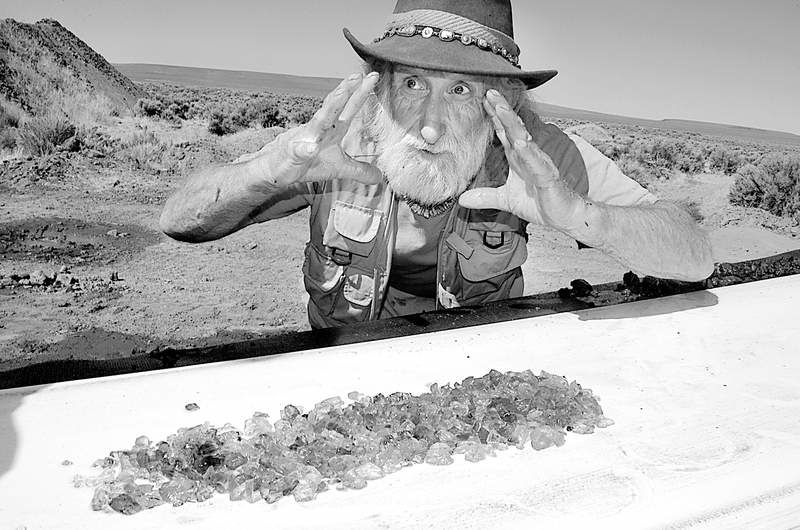Glittering sunstones draw rockhounds to sage country
Published 5:00 am Sunday, September 28, 2008

- David Knox and his wife, Cynthia, of Little River, Calif., paid $200 to pick sunstones off the conveyor belt of the Spectrum Sunstone Mine. They collected 3 to 4 pounds of the rocks. “This is like living a dream,” David Knox said.
PLUSH — Out where the sagebrush hugs the sky and the antelope roam nearby, there are sunbeams in stones, there for the taking.
“Plush diamonds” they were called by the lonesome cowboys who first stumbled upon sparkling stones while riding across the Rabbit Basin — a vast, flat stretch between Hart Mountain and Lake Abert, 70 miles northeast of Lakeview and 20 miles north of the hamlet of Plush.
“Heliolite,” said the geologists, using the scientific name for the transparent crystals of feldspar.
Oregon sunstones is what these sparklers of the purple sage country are commonly called now, and their glitter in hues of yellow, pink, red, and (rarely) blue and green attracts people looking for a gem of an adventure and maybe a chance to make a little money.
Charlie and Ruth Freeman drove 420 miles from Beaverton — the last 22 on a dusty, washboard gravel road — to sift dirt through a screen in search of sunstones.
Like many Oregonians, the Freemans had never heard of the gem until recently, even though the 1987 Legislature designated the Oregon Sunstone the official state gem (not to be confused with the thunderegg, which is the state rock).
The Freemans came to the Spectrum Mine because “we saw it on TV, and she likes digging for pretty stuff,” Charlie Freeman said.
Spectrum Sunstone Mine was first featured on the Travel Channel’s “Cash and Treasures” show a couple of years ago, and the program has rerun several times since then. Spurred in part by that publicity, about 7,000 people visited Spectrum Mine last year, according to manager Jessica Schenk. “This year, it’s been a little less because of the price of gas.”
Many sunstone seekers prospect for free.
The Bureau of Land Management in 1972 set aside four square miles where hobbyists can collect sunstones for free. The free public-use area includes a camping site with one pit toilet and a couple of covered picnic tables. But there’s no water, and the nearest power line is 20 miles away.
Spectrum Sunstone Mine provides piles of sunstone-bearing soils that anyone can sift through without charge and keep what they find.
“It’s unprocessed, so you have a good chance of finding sunstones,” Schenk said. “You can find about a half a sandwich bag of sunstones if you work at it all day.”
Upping the odds
But the odds of finding lots of high-quality sunstones improve by sifting through the highest-grade ore, selected for commercial processing.
Visitors can get access to that ore for a fee, and many serious rockhounds are willing to pay for the opportunity to collect more sunstones in less time.
For example, David Knox, of Little River, Calif. — a white-bearded gent who looks like a prospector right out of Central Casting — paid $200 for the right to pick sunstones off the mine’s commercial screening plant conveyor belt for one hour.
“We keep hearing about this place and thought we’d give it a try,” said Knox’s wife, Cynthia.
Less than 30 minutes later, she was as giddy as a girl grabbing Easter eggs on a park lawn — only she was gathering a jar full of gems.
“This is like living a dream,” Knox said. “It’s amazing. …You’re not working hard at all — I didn’t know you could do it this way.”
The Knoxes collected 3 to 4 pounds of sunstones in their hour, during which the plant’s mechanized screens sifted likely material from about 6 tons of dirt and larger rock.
Reed and Debra Grote, of Redmond, preferred to prospect for sunstones the old-fashioned way. They paid $125 for the right to spend a day digging in a pit “claim” where a layer of high- grade, sunstone-bearing ore had been exposed by a backhoe.
They were hoping to find a vein or “nest” of the crystals that formed in an 11 million-year-old lava flow. The basalt has since decomposed, revealing loose gemstones. Erosion helps bring the gemstones to the surface, making them easy for modern-day sunstone cowboys to spot.
“If we find a vein, then we’ll be doing good,” said Debra Grote, who already had a plastic bag with a handful of glittering stones she’d found one by one.
“It’s fun” to chip sunstones out of the surrounding rock and soil with a small miner’s hammer, she said, “You can see what you’re getting right away.”






